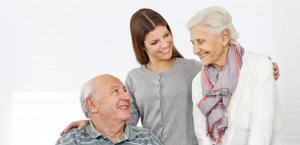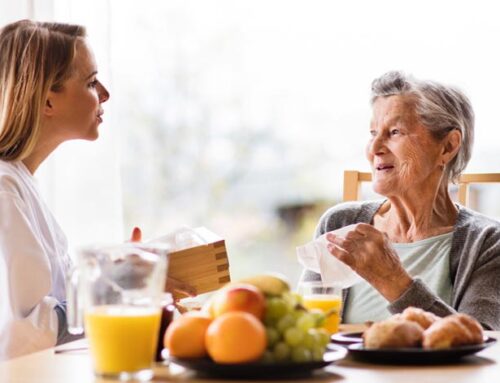Safe and Easy Tips to Prevent Falls in Every Room in Your House
For every potential fall, there is a precaution that can be taken to avoid it. If you are the caregiver of an ailing or elderly parent while managing your own household and raising your kids, you are part of the sandwich generation, meaning you are sandwiched in between the needs of your parent and the needs of your children and/or spouse. Primary caregivers of aging parents have to initiate many difficult but necessary changes in the best interest of their parents’ health and well-being, including home and lifestyle modifications to prevent falls.

Tips for Caregivers
The risks and potential complications of falls can become a self-fulfilling prophecy for many seniors. Research indicates that the fear of falling actually increases the risk of falling. According to the Centers for Disease Control, “many people who fall, even if they are not injured, develop a fear of falling. This fear may cause them to limit their activities, which leads to reduced mobility and loss of physical fitness, and in turn increases their actual risk of falling.”
Understanding is essential, and utilizing the following methods can mitigate resistance and defiance to change:
- Let them feel in control. Present the changes that you are introducing as projects your parent will manage – that they are implementing – even if this might not be the case. Saying things like, “Mom, let’s go shopping for some pretty lamps for the living room,” is more positive and helpful than saying, “you need better lighting or you’ll fall.”
- Let them keep their role as parent. Communicate to your parents that these changes help you as much as it helps them. Tell them your own peace of mind depends on knowing that they are safe.
- Highlight their independence. Share the statistics on the dangers and consequences of falls, and highlight that safety measures like installing grab bars and starting an exercise program can prolong independence and mobility.
- Enlist expert influence. If none of these tactics help, you may need to bring in expert advice. Consider asking a doctor, lawyer, or senior advisor to recommend or even prescribe that your parent take safety precautions against falls.
Room-by-Room Fall Prevention
The majority of older adults’ falls occur in the home, and the associated risks and prevention tactics vary by room. The following is a room-by-room guide to home fall statistics and recommended safety measures.
Bathroom Fall Prevention
Injuries in or near the bathtub or shower account for over two-thirds of emergency room visits, and are four times more likely to occur getting out of the tub or shower than into it. Injury-proofing your bathroom is very important, but also very easy to do. The following safety steps will help prevent bathroom falls:
- Make sure towels, soap and shampoo are within easy reach from the shower or tub.
- Grab Bars: Install anchor grab bars in and around the shower, bathtub and toilet. Test them for strength and stability.
- Ensure there are also places to sit and take care of grooming activities like brushing teeth.
- Put nightlights or motion lighting on the path from the bedroom to the bathroom, and in the bathroom itself.
- Non-skid Mats: A non-skid mat will help prevent falling in a bathtub, onto a tiled floor or making impact with a fixture that may result in a severe injury.
- Tub and Bathroom Seating: A bath stool, shower chair or a bath lifter (for the tub only) will help reduce falls in a slippery environment.
- Toilets can be modified with a raised toilet seat. A higher rising toilet can also be installed.
Kitchen Fall Prevention
Kitchen safety is one of the most important types of home safety to practice for the elderly, next to bathroom safety. Kitchen falls are most often caused by either reaching or climbing for objects out of reach, or by wet floors from spills or cleaning.
- Lighting: Make sure light switches are located at all entrances to the kitchen, and that there is enough light at the range, sink and countertop areas. Install night lights and/or motion lighting. The Light ‘n Go Mobility Light can latch onto a cabinet handle and help light the way.
- Counters: Ensure there is plenty of counter space and keep regularly used items there.
- Cabinets: Keep all cabinet doors and drawers closed when not in use. Use a reaching device like the Hand Held Reacher so you do not need to climb for items, and store your most commonly used household items on lower shelves for easy reach.
- Do not try to carry too many things at once, and have a place near your door to put packages and groceries down while you close the door and get ready to put items away.
- Never stand on chairs or tables. If you do have to climb for something, use a footstool with handrails and a non-skid rubber platform.
- Floors: Install non-slip, anti-glare flooring. Always wipe up spills quickly and make sure they have been thoroughly cleaned. If you have rugs, make sure they are attached to the floor securely with double-sided tape.
Living Space Fall Prevention
For seniors with decreased strength and mobility, just getting up from a chair or bed, or opening a door can be difficult and can lead to falls.
- Place a lamp and telephone within easy reach of your bed.
- Sleep on a bed that is easy to get in and out of or use a home bed assist rail for assistance.
- Place a cane near a bedside table to help stay steady.
- Arrange clothes in your closet so they are easy to reach.
- Use a shoe horn, dressing stick, and/or sock aid to help you as you dress for the day.
- Put in a night-light so you can see where you’re walking after dark.
Living Areas:
- Arrange furniture so you have clear pathways.
- Remove area or throw rugs or use non-slip backing tape so the rugs will not slip.
- Keep electrical and telephone cords out of walkways.
- Do not sit on a chair or sofa that is too low and makes it difficult to stand up.
- Install light switches at the entrances to rooms so you do not have to walk into a dark room to turn on a light.
- Remove papers, boxes, books, clothes, shoes and all clutter from pathways.
- Wear shoes both inside and outside the house. Avoid going barefoot or wearing slippers.
- Improve the lighting in these rooms.
What are some lifestyle changes you’ve made to prevent the risk of falls in your home? Let us know in the comments below!
References:
Costs of Falls Among Older Adults, Important Facts about Falls (CDC: Centers for Disease Control)
National Council On Aging
Wisconsin Department of Health
Griswold Home Care
How Often Falls Occur, Medical Conditions (Learn Not to Fall)
National Safety Council
New York Times
She Knows – Health & Wellness
Drive DeVilbiss Healthcare manufactures a complete line of durable medical equipment; founded on the principles of thoughtful leadership, delivery of exceptional products to partners and consumers. The mission statement of Drive DeVilbiss is, “Drive exists to enhance the quality of life of the people we touch.”





